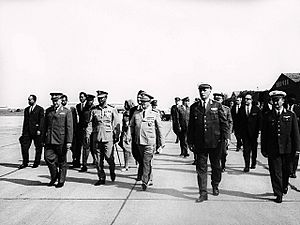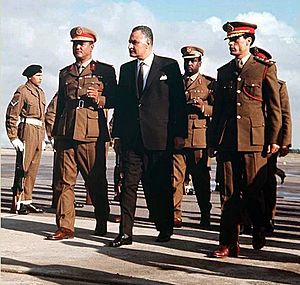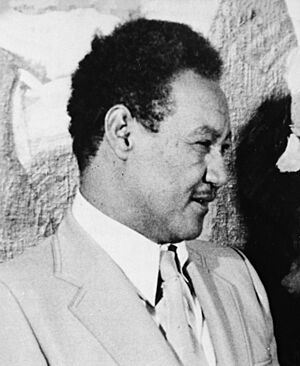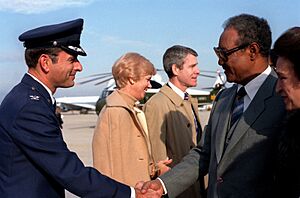Jaafar Nimeiry facts for kids
Quick facts for kids
Jaafar Muhammad Nimeiry
جعفر محمد النميري |
|
|---|---|

Nimeiry in 1983
|
|
| Chairman of the National Revolutionary Command Council | |
| In office 25 May 1969 – 12 October 1971 |
|
| Deputy | Babiker Awadalla |
| Preceded by | Ismail al-Azhari |
| Succeeded by | Himself as the President |
| 4th President of Sudan | |
| In office 12 October 1971 – 6 April 1985 |
|
| Vice President | First Vice Presidents Abel Alier Mohamed Al-Baghir Ahmed Abuelgasim Mohamed Hashim Second Vice Presidents Abdul Majid Hamid Khalil Omar Muhammad al-Tayib |
| Preceded by | Himself as the chairman of the National Revolutionary Command Council |
| Succeeded by | Abdel Rahman Swar al-Dahab |
| 9th Prime Minister of Sudan | |
| In office 28 October 1969 – 11 August 1976 |
|
| President | Himself |
| Preceded by | Babiker Awadalla |
| Succeeded by | Rashid Bakr |
| In office 10 September 1977 – 6 April 1985 |
|
| President | Himself |
| Preceded by | Rashid Bakr |
| Succeeded by | Al-Jazuli Daf'allah |
| Personal details | |
| Born | 26 April 1928 Omdurman, Anglo-Egyptian Sudan |
| Died | 30 May 2009 (aged 81) Khartoum, Sudan |
| Political party |
|
| Military service | |
| Allegiance | |
| Years of service | 1952–1985 |
| Rank | |
Jaafar Muhammad an-Nimeiry (born April 26, 1928 – died May 30, 2009) was a leader from Sudan. He served as the president of Sudan from 1969 to 1985.
Nimeiry was a military officer. He became president after a military takeover in 1969. He created a system where his party, the Sudanese Socialist Union, was the only legal political group. Nimeiry followed ideas of socialism and Pan-Arabism. He worked closely with leaders like Gamal Abdel Nasser of Egypt and Muammar Gaddafi of Libya.
In 1971, Nimeiry survived a coup attempt that was supported by the Soviet Union. After this, he formed alliances with Mao Zedong of China and later with the United States. In 1972, he signed the Addis Ababa Agreement. This agreement helped end the First Sudanese Civil War.
Later in his rule, Nimeiry also adopted some Islamic ideas. In 1983, he made Sharia (Islamic law) apply across the whole country. This decision led to the start of the Second Sudanese Civil War. He was removed from power in 1985 and went to live in Egypt. He came back to Sudan in 1999 and ran for president in 2000, but he did not win.
Contents
Early Life and Education
Jaafar Nimeiry's family came from Dongola, a city in Northern Sudan where many Nubian tribes live. He went to primary and elementary school in Omdurman. Then he attended secondary schools in Wad Madani and Hantub, which had a British style of education.
He later studied at Khartoum University College. However, he wanted to join the military. So, he graduated from the War College in Omdurman in 1952. He also earned a Master's degree in Military Science from the United States Army Command and General Staff College in Kansas, United States, in 1966.
Nimeiry held different roles in the Sudanese Army. In 1955, he was suspected of planning a coup d'état (a military takeover) against the government. But there was not enough proof to show he was involved. He was questioned again about another failed coup attempt, but no evidence was found against him.
In December 1966, some officers tried to take over the presidential palace. Colonel Gaafar Nimeiry was arrested among 400 people. He was released in January 1967.
Years in Power (1969–1985)
Taking Control and Early Changes
On May 25, 1969, Colonel Nimeiry and four other officers overthrew the government. This event was called the "May Revolution." He became the head of the Revolutionary Command Council (RCC). The next day, he stopped the constitution and closed down political parties. He also promoted himself to major-general.
Nimeiry became prime minister in October 1969. He began to change Sudan's economy. He took control of banks and industries for the government. He also made some changes to land ownership. He used his power to introduce socialist and Pan-Arabist ideas.
In 1970, Nimeiry ordered an air attack on Aba Island. This attack killed many members of the Umma Party, who were against him.
In 1971, Nimeiry was elected President. He won with 98.6 percent of the votes. He then ended the RCC and created the Sudanese Socialist Union. He said this was the only legal political group. In 1972, he signed the Addis Ababa Agreement. This agreement gave some self-rule to the non-Muslim southern part of Sudan. It ended the First Sudanese Civil War and brought 11 years of peace to the region. In 1973, he wrote a new constitution. It said Sudan was a democratic, socialist state and gave the President a lot of power.
Coup Attempts and New Alliances

Nimeiry faced several attempts to remove him from power. In 1970, Sadiq al-Mahdi, a religious leader, tried to overthrow him. In 1971, Nimeiry was briefly removed from power by a Communist coup. However, he was quickly put back in charge. During this coup, Nimeiry escaped by jumping out of a window when his supporters came to help him.
After this coup, Nimeiry started to move away from the Soviet Union. He began to get weapons from the US and Maoist China. In 1972, he signed a deal with China. Chinese military advisors started training the Sudanese Army. China also sold MiG-19 fighter jets to Sudan. Mao Zedong gave Sudan loans without interest. Chinese companies also built factories, roads, bridges, and conference centers in Sudan.
In 1975, another military coup attempt by Communist officers failed. Nimeiry's deputy, General Elbagir, led a counter-coup that brought Nimeiry back to power within hours.
In the mid-1970s, Nimeiry started projects to grow agriculture and industry in Sudan. He invited foreign companies to search for oil. Chevron found oil in South-Central Sudan in 1979. He also made economic policies more open. Some banks and industries were returned to private owners. Foreign investment was encouraged. In 1978, Nimeiry was chosen as the Chairman of the Organisation of African Unity (OAU).
In 1976, a group of fighters from Libya attacked Khartoum. This attack caused many deaths and made people angry at the Libyan leader Muammar al-Gaddafi. Nimeiry's government was saved when army tanks entered the city.
National Reconciliation and Later Years
In 1977, Nimeiry reached an agreement called "National Reconciliation" with Sadiq al-Mahdi, a leader who had been in opposition. Some political freedom was allowed. Sadiq al-Mahdi and members of the Democratic Unionist Party (Sudan) joined the government. Hassan al-Turabi, an Islamist leader, also returned and became Justice Minister in 1979. However, this reconciliation did not last long due to disagreements.
Nimeiry was one of the few Arab leaders who stayed friends with Anwar Sadat of Egypt after the Camp David Accords in 1978. He attended Sadat's funeral in 1981.
In 1981, Nimeiry began to move towards Islamic political rule. He joined forces with the Muslim Brotherhood. In 1983, he announced an "Islamic revolution" and made Sharia (Islamic law) apply across the country. To show his commitment, he poured a large amount of alcohol into the Nile River. This decision to apply Sharia law upset the mostly Christian and animist people in southern Sudan. He also ended the southern Sudanese government. This led to the start of the Second Sudanese Civil War.
In 1985, Nimeiry approved the execution of Mahmoud Mohamed Taha. Taha was a peaceful Islamic reformer who had been declared an apostate (someone who abandons their religion) by a Sudanese court.
His alliance with the United States grew stronger under President Ronald Reagan. American aid to Sudan increased a lot. Sudan became the second-largest receiver of US aid in Africa.
In 1984 and 1985, a long period of drought caused millions of people to face famine, especially in western Sudan. The government tried to keep this situation a secret from other countries.
Economic Challenges
Between 1980 and 1985, the value of the Sudanese Pound dropped by 80 percent. This was due to rising prices (inflation) and the renewed civil war.
The 1985 Revolution
People became very unhappy with Nimeiry's rule. They were upset about the strict Islamic law across Sudan, which affected non-Muslims. They also disliked the price increases caused by economic changes. These price increases in March 1985 led to big protests. Doctors, lawyers, and university teachers called for a protest and a general strike.
Huge demonstrations happened in Khartoum and across Sudan on April 3. The general strike lasted until April 6. On that day, Nimeiry was removed from power. This event, where people used peaceful protests to cause a change in government, is often called the 1985 Revolution.
Exile and Return
On April 6, 1985, Nimeiry was on a visit to the United States of America. He hoped to get more financial help from Washington. While he was away, his defense minister, Gen. Abdel Rahman Swar al-Dahab, led a peaceful military coup and removed him from power. After this, Sadiq al-Mahdi, who had tried a coup against Nimeiry in 1976, became Prime Minister.
Nimeiry lived in Egypt from 1985 to 1999. He returned to Sudan in May 1999 and received a big welcome. The next year, he ran for president against the current president, Omar al-Bashir. He did not win, getting only 9.6% of the votes. Many opposition groups did not take part in these elections, saying they were unfair.
In 2005, Nimeiry's party joined with the ruling National Congress of Sudan. The National Congress helped negotiate an end to the Second Sudanese civil war. A peace agreement was signed on January 9, 2005.
Nimeiry passed away peacefully at his home in Omdurman on May 30, 2009. Tens of thousands of people attended his official funeral. After his death, his party continued with some changes. Some supporters formed new groups, like the May Socialist Union. Another group, led by Professor Dr. Fatima Abdel Mahmoud, created the Sudanese Socialist Democratic Union Party. Dr. Abdel Mahmoud was the first woman cabinet Minister in Sudan in the 1970s. She was also the first Sudanese woman to run for president in the 2010 Sudanese election.
See also
 In Spanish: Yaafar al-Numeiry para niños
In Spanish: Yaafar al-Numeiry para niños






